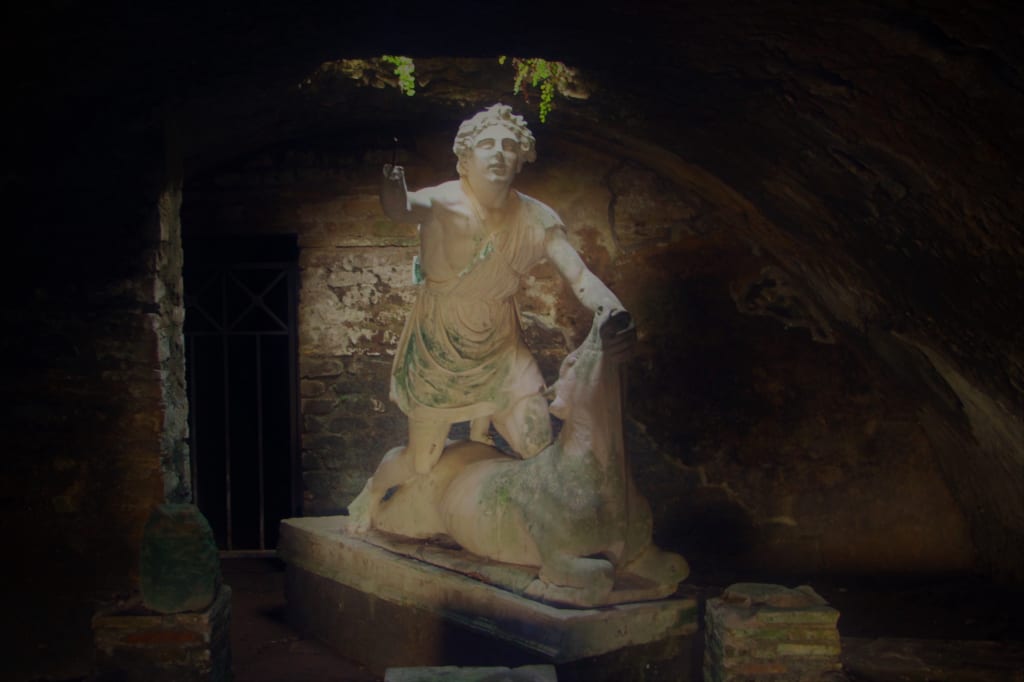Ostia Antica: The Other Pompeii
Just outside Rome, an archaeological marvel awaits

The hand that used to hold the knife is gone.
But the same sunlight still comes streaming down from the trapdoor above, illuminating the cold and changeless features of a forgotten god. The bull is still there too, its head pulled back, throat exposed for the vanished blade. Damp ferns grow around the edges of the skylight above the marble statue.
If you like your vacation with a dash of history and a side order of creepiness, you’ll love it here.
It’s possible to reach Pompeii from Rome.
Two and a half hours in a car or four hours by train will bring you to the legendary Roman city under its frowning volcano, two ancient lovers locked in an abusive embrace. But it’s a long way to go. And if you’re lucky enough to find yourself in Rome, you should try to spend as much time in this most enchanting of cities as you can.
Italy’s capital hardly lacks ancient ruins. What’s most charming about Rome is the melting and merging of so many different eras. The Roman temple becomes a Christian church becomes an aristocrat’s palace, so you can stand in one square and see the last 2000 years represented in a single tourist-crowded sun-dappled moment.
And if you want to see a Roman city that’s intact but for the ravages of time, there are other options. Ostia Antica can be reached by train and subway in only 30 minutes.
Ostia is easy to reach, and yet it only receives around 300,000 tourists per year. Pompeii gets two and a half million. Even with a prodigious imagination, anyone who’s been knows that Pompeii loses some of its fascination when you share it with hundreds of sweating tour groups and loudspeaker-toting guides. Ostia, the ancient port of Rome, gives you a chance to escape the crowds that’s hard to find in Italy.
In fact, when I visited on a bright, crisp day in January, the town was almost deserted. The low sun cast atmospheric shadows over the flat paving stones of the old Roman roads and pooled in the sharp-edged letters of marble inscriptions. Wandering through the Imperial warehouses and storehouses, the palaces and the pubs, the open-air theater that every Roman town had to have, it’s possible to find yourself completely alone.
It’s possible to find yourself rubbing shoulders with the dead, clasping forearms and exchanging greetings. And even as heavy-bellied planes roar overhead on the way to Fiumicino airport, it’s easy to believe you’ve stepped back in time.
And Ostia has one thing Pompeii lacks: a Temple of Mithras.
I used to be an altar boy.
And although I’ve long since left behind the trappings of Catholicism and any other religion, there’s still enough of the Papist left in me to find these things fascinating. Old dead gods. Abandoned temples. The eerie glimpses of another world at once alien and strangely recognizable.
Mithras was a Persian god. His birthday, on December 25th, is still celebrated by Zoroastrians, one of the most ancient religions that still exists. Adopted mainly by Roman soldiers, the mysterious cult of Mithras spread across the Empire before Christianity stamped it out.
There’s a temple of Mithras in London, under streets that rumble with the weight of double-decker buses. There are temples in Spain and Switzerland, in Bosnia and Belgium, and until it was transported to Yale University, there was one in Syria.
Mithraism had seven degrees of initiation to the cult. I could, if asked, still rattle off the seven sacraments of the Catholic Church that were drilled into my head in school. A men’s cult, where women were largely absent. A mystical tradition in which food and drink were taken as part of the ritual.
When the last pope resigned, the first journalist to get the scoop was the only one in the room who could speak Latin, the language of the vanished Roman soldiers and the lingering priests. Sometimes, when the parish priest wasn’t watching, I’d sneak a gulp or two of the sacerdotal wine after mass — sacerdotes were the priests of Mithras. The first Christian Roman Emperor was a soldier, too. It’s only the chaotic happenstance of history that saw me, 2000 years later, indoctrinated into one mystery cult and not the other.
Mithras killed his sacrificial bull in a cave, and so all his temples were either in caves or made to look like them. The one in Ostia is dug into the ground, the brick arches supporting a weight of soil and grass up above so that you climb down into the small temple and out of the Roman sunshine, into the gloom.
There was no one around. Just me and the water dripping off the walls and the damaged statue of the warrior god at the other end of the cave, his handless arm raised high above the defeated bull.
Et nos servasti sanguine fuso, it says on the wall of a Mithraeum in Rome. You have saved us by shed blood. In true Catholic tradition, the church where I was an altar boy had a spectacularly gory life-size crucifix. Jesus impaled on the cross and streaming static blood, his doe eyes rolling up in agony toward an empty heaven. Bull or man or God, the sacrifice is the same. As though we can’t believe in anything unless it’s paid for in pain.
“You know, you felt awful. You had nailed that man to the cross. Because you eat steak, you have crucified Christ. Because you killed the bull. And, after all, you depend on it.
Mithra. It’s the same mystery. And what are you going to do about that? “This have I done for thee, what doest thou for me?” You feel awful that you exist at all.”
The Nature of Consciousness Part 2, Alan Watts
But in Rome, I never feel awful.
In Rome, in Italy, existence is enough. And in Ostia, as much as anywhere, you can experience the whispering sands of history all around you. At one of the many bars, you feel as though the barman might appear at any moment, asking Quid bibis? as he wipes down a cup for you.
At the theater, you sit in the sun and wait for the show to begin, the actors about to arrive any minute. And the show is going on all around you, involving you and it and the roaring planes that descend over the roofless houses of the ruined city.
If you ever get the chance, you should go to Pompeii. For that matter, you should go to Naples while you’re there, and the Amalfi coast, and Capri. That part of Italy has more than enough to justify a long trip all by itself.
But if you find yourself in Rome and want to see what the place looked like before its fall, before the bat-winged priests descended and carved out an enclave on the banks of the Tiber, you should make the quick trip out to Ostia Antica. You don’t need to be initiated into the mysteries to be seduced by the long slow hymn of sunlight and time.
About the Creator
Ryan Frawley
Towers, Temples, Palaces: Essays From Europe out now!
Novelist, entomologist and cat owner. Ryan Frawley is the author of many articles and stories and one novel, Scar, available from online bookstores everywhere.






Comments
There are no comments for this story
Be the first to respond and start the conversation.